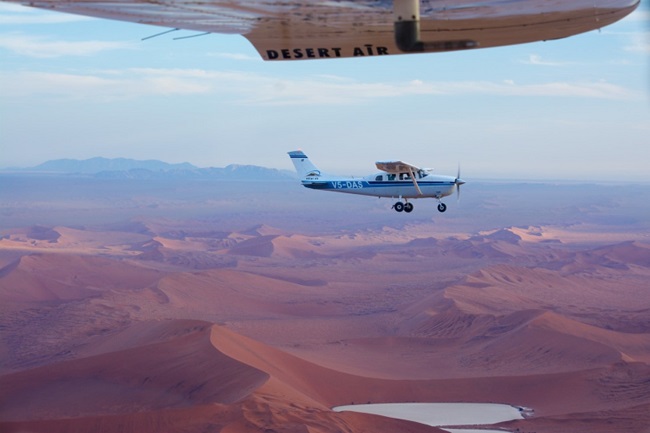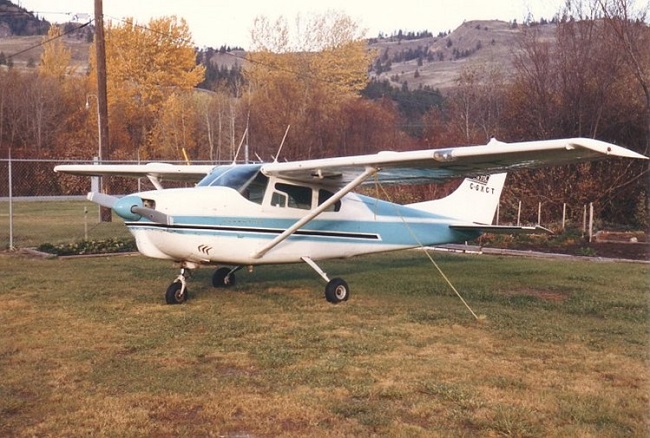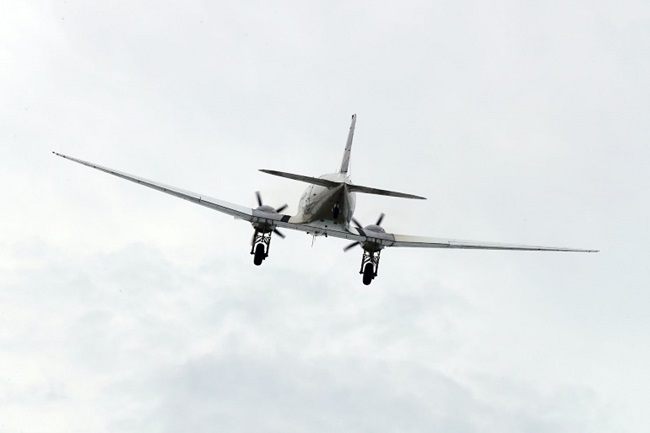By Paul Wiley
Years ago, when I was first learning to fly at Luke Aero Club, my flight instructor explained to me the concept of “see and be seen” as the cornerstone of mid-air collision avoidance in VFR conditions. He stressed the importance of looking outside the cockpit and being vigilant at all times in looking for other air traffic, especially in the local traffic pattern. I remember him saying that while rare, mid-air collisions often result in fatal accidents.
The risk of a mid-air collision must be understood and mitigated to the maximum extent possible to minimize the potential for a collision.

In this article I will use two examples of near mid-air collisions I’ve experienced in my 40+ years of flying and teaching people to fly to illustrate lessons learned regarding mid-air collision avoidance. Additionally, I will provide references to techniques for scanning for traffic and tips on how to reduce the risk of a mid-air collision.
First of all, let’s face it: other aircraft are not always easy to see when we are flying. Certain weather conditions and the position of the sun and horizon relative to traffic can make it very difficult to see other aircraft. Anything we can do to make it easier for other pilots to see us is helpful, e.g. using our aircraft lighting day and night, being at the correct altitude when in the traffic pattern, being precise when stating our position and following the prescribed procedures for whatever operation we are performing. This includes remaining at the required distances from clouds for the airspace within which we are flying.
First Example Background
This incident occurred some years ago in southern California’s busy airspace. I had departed IFR from Burbank and was headed back to the Phoenix area in a Cessna 210. The sun had just set a few minutes earlier and Burbank weather was low IFR, something like ceiling indefinite, sky obscured, visibility ¾ of a mile in fog and there was a layer of low stratus clouds as well. I recall that the tops of the clouds were reported to be around 6,000 feet MSL.

I was being vectored southbound to intercept the airway where I would turn back east and homeward once I was established on the airway. During my climb, Air Traffic Control (ATC) informed me of “traffic at 12 o’clock, 10 miles, opposite direction, altitude unknown”. Note that this was when mode C was required for the airspace I was flying in, but this traffic was not squawking altitude. I replied: “roger, I’m on the gauges” meaning I was in the clouds and could see nothing outside. Shortly thereafter, ATC called again: “traffic at 12 o’clock, 5 miles, opposite direction, altitude unknown”, and again, I stated that I was still in cloud. Once more ATC called: “traffic at 12 o’clock, less than a mile, opposite direction, altitude unknown”, and again, I stated that I was still in cloud. However, by now I was starting to see more light above me and was anticipating that I would break out of the clouds in my climb very soon.
As soon as I climbed out of the clouds, and I mean within seconds, a Bonanza passed directly overhead and very close going very fast. I estimate that had I exited the clouds a few seconds earlier or climbed just a bit faster we would have collided “spinner to spinner”, i.e. head on; and at our respective speeds this would have undoubtedly been a fatal accident for all involved and possibly for some on the ground as well. The Bonanza was cruising just above the tops of the clouds (clearly illegal). And as I was climbing at 120 knots and the Bonanza was probably flying even faster; our closing rate was most likely greater than 250 knots. I reported this to ATC as a near mid-air collision, but there was little else to be done at that point. I doubt the Bonanza pilot ever saw me or realized how close to a disaster he had come.

First Example Lessons Learned
My first thought was that I should have requested a vector around this traffic from ATC after the second call (and certainly after the third call). A turn 10 degrees to the right or left would have been easy to accomplish and added very little time to my flight home. Additionally, I was shocked and appalled by the recklessness of the Bonanza pilot. I presumed the traffic was at least 1,000 feet above the cloud tops. However, being “dead right” in this instance would have been a small consolation to my survivors and especially to me! I also (naively and falsely) believed that the controller would keep me clear of all traffic when I was flying in Instrument Meteorological Conditions (IMC) on an IFR flight plan. Clearly, I did not fully understand the risks and did not take full advantage of my authority as Pilot in Command to properly use all resources available to me.
If ATC calls out traffic that you cannot see, regardless of whether you are flying in Visual Meteorological Conditions (VMC) or IMC, you should never hesitate to request a vector around traffic. And as a side note: many of us now fly aircraft equipped with avionics that provide assistance for collision avoidance, e.g. TCAS and ADS-B. I frequently hear pilots say: “I have the traffic on TCAS”. There is no substitute for visually seeing and avoiding other traffic while flying in VMC. Aides to collision avoidance (like TCAS) are there to assist you, the pilot, but one should never rely solely on cockpit displays for collision avoidance. Always verify traffic visually.

Second Example Background
The second example occurred in the traffic pattern at Scottsdale airport. I was flying right seat with the Commercial/Instrument rated owner of a Cessna 182RG in the left seat. We were practicing take-offs and landings. While on the upwind leg for runway 3, we heard a pilot in a Piper Cherokee call 5 miles north of Scottsdale tower for permission to transition the Scottsdale class D airspace from the north to the south. Scottsdale tower instructed the pilot to cross mid field at or above 3,000 feet and cleared the pilot through the class D airspace. The Cherokee pilot acknowledged this clearance.
Just as we were turning from crosswind to a left downwind and leveling off at the pattern altitude of 2,500 feet, I saw the Cherokee at my 1 o’clock position, same altitude, and very close. At the same time, the pilot in the left seat was head down focusing on level off and rolling out of the turn to downwind and thus did not see this traffic. Instinctively, I grabbed the yoke and turned hard left and pushed forward. However, by the time I had done this and before our plane even responded to my control inputs, the Cherokee was at our 9 o’clock position and the threat of the collision had passed.

In summary, the Cherokee pilot was 500 feet lower than he should have been and at least a mile further east of mid field as well. I immediately called Scottsdale tower and reported a near mid-air collision. The tower controller then reprimanded the Cherokee pilot and asked him to call the tower when he landed. And that was the last we heard of this incident.
Second Example Lessons Learned
I believe I did not see the Cherokee sooner because of two reasons: 1) I was looking in the wrong place and 2) the rather large side post was a “blind spot” partially blocking my view of where the Cherokee actually was. Complacency on my part was an issue as I was not moving my head enough to look around the blind spot. Additionally, the left seat pilot was one of the better pilots I’ve flown with (he is now an airline pilot) and he was always very good about looking outside for traffic. So here you have two conscientious pilots looking for (but not seeing) dangerously close traffic.
The traffic pattern is a high workload environment. Approximately half of all mid-air collisions occur in the traffic pattern according to the 28th annual Nall report available through AOPA Air Safety Foundation. It is also where increased vigilance is required to avoid a collision. Never assume a pilot’s reported position is his actual position – always verify visually.

References, Techniques and Tips
A few words about vision taken from the Aeronautical Information Manual (AIM): The eye can see an arc of about 200 degrees of the horizon at a single glance. However, only the small center area of the eye (called the fovea) can send a sharp image to the brain for action by the pilot. All other visual information not processed through the fovea will be of less detail. An aircraft that is in sharp focus (within the foveal center of vision) at 7 miles would have to be as close as 7/10 of a mile in order to be recognized as a threat when viewed peripherally i.e. outside of the foveal area.
All pilots are required to have good vision in order to fly. However, to paraphrase the AIM: “the ability to read an eye chart does not ensure that one will be able to efficiently spot other aircraft.” Therefore, in order to minimize the risk of a mid-air collision, pilots must develop an effective way to scan for other traffic. Effectively scanning the sky for other traffic is critical to mid-air collision avoidance. Studies show that pilots should spend about 75% of their time focused outside the cockpit. See Tips below for information about how to effectively scan for traffic.

FAR 91.111 (a) states: “No person may operate an aircraft so close to another aircraft as to create a collision hazard.” Well, that’s short and to the point, but much more helpful information about how to avoid a collision is located in the AIM and other sources cited below. Additionally, all Airman Certification Standards require proper scanning technique and attention to collision avoidance. Clearly obtaining the necessary knowledge, understanding the risk and developing the skills to avoid collisions is key to demonstrating the competency required of any pilot at any skill level.
The AIM has two sections which provide important and helpful information:
- ·8-1-6 – Vision in Flight: especially section “C” Scanning for Other Aircraft
- ·8-1-8 – Judgement Aspects of Collision Avoidance
Become familiar with and understand the following related to collision avoidance: determining relative altitude, multiple threats, collision course targets, high hazard areas, cockpit management, windshield conditions, visibility limitations, visual obstructions in the cockpit, effects of hypoxia on vision (especially at night), empty field myopia, eye fatigue, dark adaptation and refocus time.

AOPA’s web site has an excellent video (about 10 minutes long) on mid-air collision avoidance. See AOPA’s Air Safety Institute and search for mid-air collision avoidance
The FAA safety.gov website also has hundreds of resources related to collision avoidance. Spend some time on this site researching techniques for avoiding a mid-air collision.
Techniques/Tips
Develop good scanning techniques by:
- Dividing the windshield into segments of approximately 10 degrees. Scan slowly and focus on each segment for 1 to 2 seconds. This will bring each segment into the central visual field of view to accomplish effective viewing. Concentrate most of your viewing at your approximate altitude as traffic well above or below your current altitude would not normally be a threat unless they are climbing or descending very rapidly. Most pilots prefer to start from over their left shoulder and proceed scanning left to right.
- Teaching your passengers how to scan for traffic. Younger passengers especially can be very helpful in spotting traffic as they often have excellent vision. This can have the added benefit of keeping your passengers involved in the flight.
- Make your aircraft more visible to other traffic by using aircraft lights and when appropriate by maneuvering. An aircraft that is turning is often easier to see than one flying straight and level.
- Fly at the recommended altitude, especially in the traffic pattern.
- Be as accurate as possible with position reports.
- Check NOTAMS for the airport(s) you will be flying to/from so that you will be aware of collision hazards, e.g. parachute jumping.
- Ensure your vision remains sharp by regular check-ups with your eye doctor.
- Ensure you are alert by using the IM SAFE checklist prior to every flight.
Maximize your knowledge regarding mid-air collision avoidance, understand the risk and maintain “vigilance” and you can be confident that you are doing everything possible to avoid a mid-air collision.

